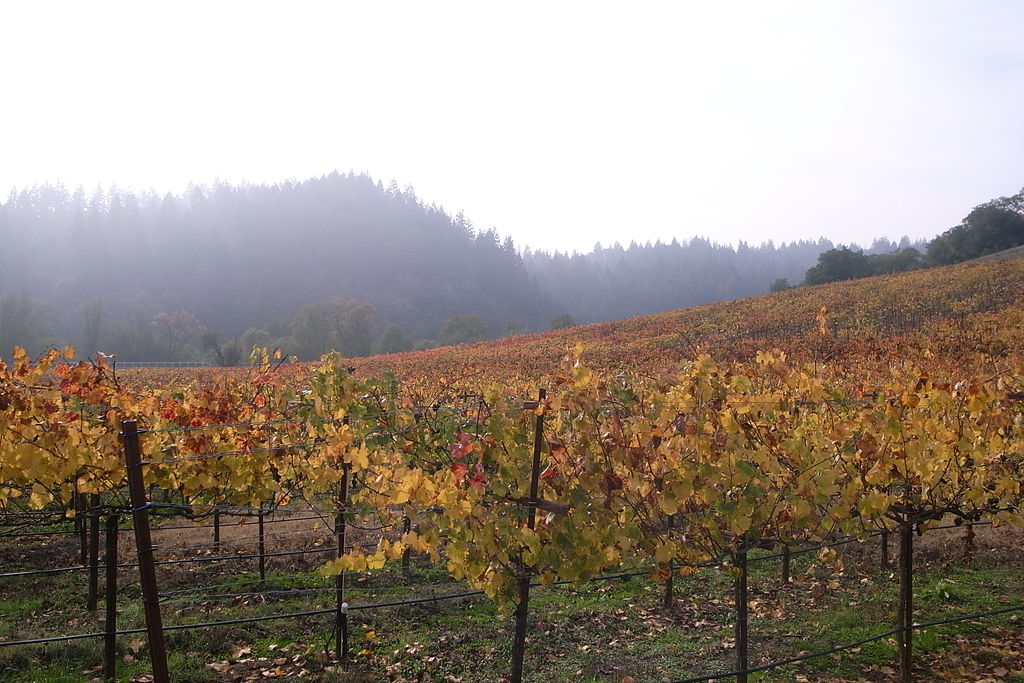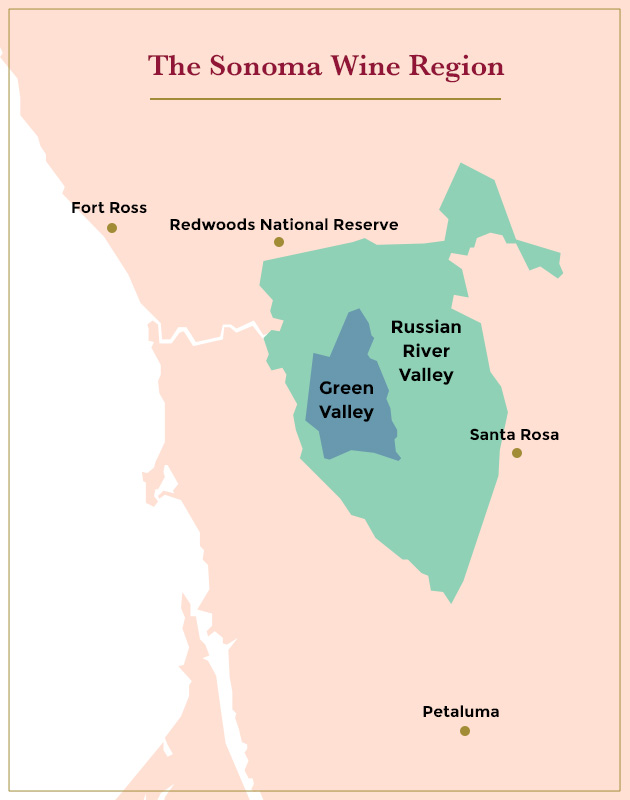
The Russian River Valley wine region has a cool, foggy climate that is ideal for growing Pinot Noir and Chardonnay. Photo Credit: Wikimedia Commons user Naotake Murayama
If you were to rank the best American Viticultural Areas (AVAs) in the United States, the Russian River Valley wine region would be near the top of the list. This California AVA located in Sonoma is tremendously well-respected among wine experts, who consider it one of the greatest regions in the world for growing complex Pinot Noir and Chardonnay. Unlike other regions of California, which tend to be hot and dry, the Russian River Valley is unusually cool and dense with fog. Many of the wines made here are acidic, elegant, and multilayered. These are luscious wines that every collector should experience at least once in a lifetime.Â
Our guide to the Russian River Valley wine region covers the finest wines from this AVA, including the subregions that grow the best grapes, the producers that craft the most complex wines, and the most age-worthy vintages for your collection. Discover what makes this region so beloved among serious wine enthusiasts.Â
Why Russian River Valley Grapes Are So Complex Â
The Russian River Valley wine region is ideally suited for growing some of the finest cool-weather grapes in the world. The AVA is located at the center of Californiaâs Sonoma County, about eight miles inland from Sonomaâs Pacific coastline.Â
 This region was named after the nearby Russian River, which runs through the northern part of the area. This close proximity to two different bodies of water gives the Russian River Valley wine region its famously cool, foggy climate. Ocean fog travels from the coast into the Russian River Valley through the Petaluma Gap (a famous valley in the coastal mountain range) and covers the hills in a thick blanket of mist for most of the day. Meanwhile, the Russian River and the many creeks that surround it keep the air consistently cool, even after the fog clears in the mid-afternoon.Â
This region was named after the nearby Russian River, which runs through the northern part of the area. This close proximity to two different bodies of water gives the Russian River Valley wine region its famously cool, foggy climate. Ocean fog travels from the coast into the Russian River Valley through the Petaluma Gap (a famous valley in the coastal mountain range) and covers the hills in a thick blanket of mist for most of the day. Meanwhile, the Russian River and the many creeks that surround it keep the air consistently cool, even after the fog clears in the mid-afternoon.Â
These conditions are ideal for producing Pinot Noir and Chardonnay because these grapes taste more complex when they are able to ripen slowly on the vine. In hot, dry climates, wines made using these varieties are sometimes high in sugar but lack acidity and complexity. In the Russian River Valley wine region, Pinot Noir and Chardonnay taste both more austere and nuanced because the fog and chilly conditions slow down the ripening process. Some producers harvest their grapes as late as October or November to allow the fruit to ripen completely.Â
The Russian River Valley AVA is incredibly diverse and varied in climate.
Another unique quality of Russian River Valley wine is that grapes grown on the highest elevations are generally bolder and more fruit-forward in flavor than those grown on the shallower slopes. This is the opposite of most winegrowing regions, where higher elevations are usually ideal for growing cool weather grapes because temperatures are cooler on the uppermost hills. In the Russian River Valley, though, fog doesnât always reach the tops of the hills, so the temperature is usually warmer. The highest hills are also exposed to more direct sunlight during the day, so the fruit tends to ripen faster. Youâll find high-quality Zinfandel and Syrah made from grapes grown at these elevations, such as 2012 Martinelli Hop Barn Hill Syrah and 2005 Martinelli Jackass Vineyard Zinfandel.Â
While the Russian River Valley is, on the whole, cooler and foggier than other regions of California, this AVA is incredibly diverse and varied in climate. Some subregions of the AVA are known for producing very elegant and age-worthy wines whereas others tend to produce more approachable styles. To find the very best wines from the Russian River Valley wine region, you need to dive deeper into each individual subregion.Â
Notable Russian River Valley SubregionsÂ
The Russian River Valley wine region consists of five notable subregions.Â
 Middle ReachÂ
Middle ReachÂ
This northernmost subregion is home to some of the oldest plantings of Pinot Noir grapes in the Russian River Valley. Light fog rolls into this region from the Russian River, yet this area as a whole is less foggy than some other subregions of the Russian River Valley. This means that temperatures are slightly warmer, and as such the wines are less acidic and have richer, more fruit-forward flavors. Pinot Noir from Middle Reach still isnât as concentrated or high in sugar as wine made in warm California AVAs, but it is broader on the palate than most other Pinot Noir from the Russian River Valley.Â
Laguna RidgeÂ
Like its northern neighbor Middle Reach, Laguna Ridge is classified as a medium-cool subregion. This area is famous for its unique soil compositionâa mix of Gold Ridge and Altamont soils. Gold Ridge soils are sandy and fine and drain water very effectively. Vineyards with a large amount of Gold Ridge soil tend to produce more concentrated Pinot Noir, as the grapes donât retain a great deal of water. Altamont soils contain more clay, which holds water deep underground. In areas with a high concentration of Altamont soil, Pinot Noir is more vegetal and austere. The best vineyards in Laguna Ridge have a balance of Gold Ridge and Altamont soils, which encourages the fruit to develop both excellent concentration and moderate acidity. These wines are textured and full of dark fruit flavors, particularly blackberry.Â
Santa Rosa Plains
This subregion is known for producing some of the finest Zinfandel in Sonoma. The clay-rich soil retains water in the summer, keeping the vines cool throughout the year and producing very acidic grapes. In the northern Santa Rosa Plains, the Zinfandel is full of prominent red fruit flavors, particularly cherry. Vineyards in the southern portion of this subregion produce Zinfandel that is darker in flavor, with more spice and boysenberry notes. Many of these wines can age for 15 years or more due to their high acidity levels.Â
Sebastopol HillsÂ
This southernmost Russian River Valley subregion is by far the coldest in the AVA. For years, winemakers avoided planting here because they were worried that the fruit would not ripen fully. However, top-quality producers began experimenting in this area and discovered that the terroir produces grapes that are surprisingly well-balanced despite the chilly conditions. Here youâll find Pinot Noir and Chardonnay wines that are immensely acidic and crisp but that also have other complex underlying flavors including black tea, violet, and vibrant citrus. These wines are also quite herbaceous, a quality that many wine enthusiasts find very compelling.Â
Green Valley
This is the highest quality terroir in the Russian River Valley wine region. In fact, it is so high in quality that it earned its own separate AVA distinction in 1983 (although it is still technically part of the larger Russian River Valley AVA). What makes this sub-AVA so exceptional is the perfect balance of cooling oceanic winds and warm inland sunshine. Temperatures remain quite low throughout the year, resulting in wines that are very high in acidity. However, while these wines are acidic and full of bright red fruit flavors, theyâre not light-bodied. Exposure to ample sunlight causes the fruit to ripen completely on the vine and develop great intensity and concentration. This is bold, well-structured Pinot Noir that can age for a decade or more.Â
You can find excellent producers in all of the subregions listed above. Every vineyard in the Russian River Valley wine region is slightly different, so itâs important to evaluate wines and producers individually. For the most part, the best producers are located in the Green Valley, but there are a number of other estates in this AVA that are also worthy of consideration.Â
The Top Producers from the Russian River Valley Wine RegionÂ
Many of Sonomaâs top wine producers own parcels of land all around the Russian River Valley wine region. Typically, winemakers carefully select terroirs that are ideal for growing the particular style of wine they wish to make. For example, if a producer wants to craft very acidic and powerful Pinot Noir, they will likely plant these vines in the Green Valley or somewhere nearby. Producers that want to make Cabernet Sauvignon or Merlot usually plant vines in the northeastern part of the Russian River Valley wine region, as this area is warmer and better suited to these varieties.Â
Thereâs a real sense of place in the Russian River Valley wine region.Â
This is part of what makes Russian River Valley wines so special. Winemakers in this region care deeply about the unique flavor characteristics that the terroir lends to each variety. Thereâs a real sense of place in the Russian River Valley wine region.Â
Some of the producers in this region that are crafting the finest terroir-driven wines on the market today are:Â
- Aubert: Known for rich Chardonnay.Â
- Cirq: Known for focused, full-bodied Pinot Noir and Chardonnay.Â
- DuMOL: Known for dark and spicy Pinot Noir.Â
- Kistler: Known for elegant Pinot Noir and Chardonnay.Â
- Kosta Browne: Known for lush, age-worthy Pinot Noir.Â
- Littorai: Known for linear, refined Pinot Noir and Chardonnay.Â
- Martinelli: Known for intense and complex Pinot Noir, Chardonnay, Zinfandel, and Syrah.Â
- Morlet Family: Known for steely and rich Chardonnay and Pinot Noir.Â
- Paul Hobbs: Known for complex and multilayered Chardonnay and Pinot Noir.Â
There are many other fantastic Russian River Valley producers on the fine wine market. One tip to remember as you invest in wines from the Russian River Valley wine region is that every producer has a characteristic style. This is why itâs important to try a variety of wines from multiple producers to find the labels that speak most strongly to you.Â
How Long Do Wines from the Russian River Valley Age?Â
Because wines from the Russian River Valley wine region are typically very high in acidity, many have greater aging potential than similar New-World wines made in warmer climates. However, there are still only a handful of Russian River Valley wines that will benefit from more than a decade of aging. In general, fine Chardonnay from this region is best drunk within five to seven years after release, although some labels (like Aubert Eastside Vineyard Chardonnay) can age for 15 years or more. Likewise, most Pinot Noir from this AVA is best drunk when itâs less than ten years old, though a few wines like 2016 Kosta Browne Giusti Ranch Pinot Noir may age well for 15 to 20 years and develop greater complexity with time. If youâre looking for a wine to lay down long-term, your best bet is to buy high-quality Pinot Noir, Zinfandel, or Chardonnay from the regionâs most successful recent vintages.Â
According to Wine Advocate, the most age-worthy recent Pinot Noir vintages from Sonoma are:
- 2014: Drink or hold.Â
- 2012: Drink or hold.Â
Even these top-quality vintages reach maturity much faster than Burgundian Pinot Noir. While a bottle of Domaine de la Romanée-Conti can easily age for 50 or more years, Russian River Valley Pinot Noir is much more approachable when itâs young and typically matures within 20 years.Â
A few older Pinot Noir vintages also received high scores from Wine Advocate and have already reached maturity:Â
- 2002: Drink now.Â
- 2001: Drink now.Â
- 1994: Drink now.Â
These wines arenât ideal for laying down for any period of time, but theyâre very enjoyable to drink now. If youâd like to experience what a mature Russian River Valley wine tastes like, these three vintages are great options.Â
Zinfandel from the Russian River Valley wine region is longer-lived than most New-World Zin, as these wines have high acidity.
The following are some of the best Zinfandel vintages from the Sonoma area as rated by Wine Advocate:
- 2016: Drink or hold.Â
- 2014: Drink or hold.Â
- 2013: Drink or hold.
- 2012: Drink or hold.Â
- 2003: Drink or hold.Â
Since Zinfandel isnât naturally as age-worthy or structured as other long-lived wine varieties like Cabernet Sauvignon, itâs rare to find Zinfandel wines older than 20 years that arenât past their peak. Still, Zinfandel from the Russian River Valley wine region is longer-lived than most New-World Zin, as these wines have high acidity. For example, one older vintage that may still be worth drinking is the highly-rated 1994. Top Russian River Valley Zinfandel wines from 1994 are still drinking well now, though lesser-quality wines may be past their peak.Â
As for Chardonnay from the Russian River Valley, some of the top vintages are:Â
- 2016: Drink (this vintage is maturing quickly).Â
- 2014: Drink or hold.Â
- 2013: Drink or hold.Â
- 2012: Drink (this vintage is maturing quickly).Â
- 2007: Drink or hold.Â
- 2005: Drink or hold.Â
- 2004: Drink or hold.Â
The amount of oak in the Chardonnay affects how long the wine will last. Heavily oaked wines may still be worth drinking up to 30 years after release, but the majority of fine Chardonnay from this region will be past its prime by the time itâs 20 years old. Some possible exceptions are:Â
- 1997: Drink now (may be past its peak).Â
- 1995: Drink now (may be past its peak).Â
- 1992: Drink now (may be past its peak).Â
Of course, not every wine has to be long-lived to be worth purchasing. If youâre looking for an approachable young wine that is complex and delicious after just a few years in storage, then most wines from the Russian River Valley are an excellent choice. Many collectors drink these wines while they wait for their less approachable Burgundian wines to soften and mature.Â
The Future of the Russian River Valley AVAÂ
As a relatively young AVA, the Russian River Valley wine region is still finding its footing in the wine world. Winemakers are realizing that this region has a great deal of potential and are working on improving their vineyards to take advantage of the Russian River Valleyâs many natural gifts. For example, producers are seeking out uncultivated parcels of land that appear to have the ideal combination of coastal fog, cooling winds, and generous sunshine. These producers have also seen the value in the Russian River Valleyâs unique mix of Gold Ridge, Altamont, and Franciscan Complex soils, which give the grapes superb structure, balance, and complexity of flavor.Â
In the future, we will likely see many more incredible wines from the Russian River Valley wine region.
Whether or not they are designed to age, Russian River Valley wines are very pleasurable to drink. Their naturally high acidity makes these wines ideal for pairing with many foods and they make excellent dinner party gifts. In the future, we will likely see many more incredible wines from the Russian River Valley wine region, and in the coming years, these wines will likely gain even greater aging potential as winemakers discover the best methods for cultivating, harvesting, and fermenting the multidimensional grapes that thrive in this areaâs cool weather. Starting a collection of the best wines from this region now will make you part of this history in the making.Â
Whether you are starting your high-end wine collection or adding to an established portfolio, Vinfolio is your partner in buying, selling, and professional storage. Contact us today to get access to the worldâs finest wine.
Image source:Â Naotake Murayama [CC BY 2.0 (https://creativecommons.org/licenses/by/2.0)]
The post Your Guide to the Russian River Valley Wine Region appeared first on Vinfolio Blog.


